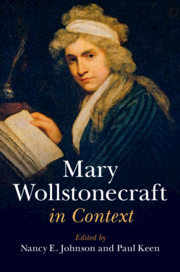Book contents
- Mary Wollstonecraft in Context
- Mary Wollstonecraft in Context
- Copyright page
- Contents
- Illustrations
- Notes on Contributors
- Preface
- Frontispiece
- Chronology
- Part I Life and Works
- Part II Critical Fortunes
- Part III Historical and Cultural Contexts
- The French Revolution Debate
- The Rights of Woman Debate
- Philosophical Frameworks
- Legal and Social Culture
- Literature
- Chapter 30 Sentimentalism and Sensibility
- Chapter 31 English Jacobin Novels
- Chapter 32 Anti-Jacobin Novels
- Chapter 33 Children’s Literature
- Chapter 34 Gothic Literature
- Chapter 35 Travel Writing
- Chapter 36 History Writing
- Chapter 37 Periodicals
- Chapter 38 Translations
- Suggested Further Reading
- Index
Chapter 33 - Children’s Literature
from Literature
Published online by Cambridge University Press: 16 January 2020
- Mary Wollstonecraft in Context
- Mary Wollstonecraft in Context
- Copyright page
- Contents
- Illustrations
- Notes on Contributors
- Preface
- Frontispiece
- Chronology
- Part I Life and Works
- Part II Critical Fortunes
- Part III Historical and Cultural Contexts
- The French Revolution Debate
- The Rights of Woman Debate
- Philosophical Frameworks
- Legal and Social Culture
- Literature
- Chapter 30 Sentimentalism and Sensibility
- Chapter 31 English Jacobin Novels
- Chapter 32 Anti-Jacobin Novels
- Chapter 33 Children’s Literature
- Chapter 34 Gothic Literature
- Chapter 35 Travel Writing
- Chapter 36 History Writing
- Chapter 37 Periodicals
- Chapter 38 Translations
- Suggested Further Reading
- Index
Summary
Mary Wollstonecraft’s literary career in the last two decades of the eighteenth century coincides with the emergence and rapid expansion and diversification of a children’s text industry in Britain. There had certainly been books produced for children in previous periods: hornbooks and battledores for learning the alphabet, Puritan-penned accounts of the deaths of godly children such as James Janeway’s A Token for Children (1673), advice and conduct books for the young of the well-to-do entering the social world are but a few examples. Yet it was not until the second half of the eighteenth century that a perceived need for a specialized literature became widespread enough to foster and sustain a significant number of publishers dedicated to its production: most famously John (then Francis, then Elizabeth) Newbery, followed by many others including Thomas Carnan, William Darton, John Marshall, and Benjamin Tabart. Wollstonecraft herself acknowledged how recent, and welcome, a development the “new” children’s literature was in an early review for the Analytical Review of Thomas Day’s The History of Sandford and Merton (1789): “The importance of books adapted to the understanding of children, has not till lately been forcibly felt in this kingdom.”1 By the time of her death, there were bookstores selling reading material for young readers exclusively; her widower William Godwin would operate one himself. These were stocked with everything from story books, movables (early pop-up books), poetry collections, plays for “home entertainments,” and abridged versions of successful novels, as well as devotional works, geographical “tours,” historical accounts, science texts, often about botany and zoology, and day planners for young people that included such practical information as London coach times and how to make change at a shop accurately. What this all suggests, as historians of childhood and scholars of children’s literature have long noted, is a significant reconfiguration of the place of the child in both the public imagination and in social practice. This reimagining of the meaning of childhood was anything but an afterthought or footnote to the grander enterprises of the late Enlightenment; it was a serious concern to many of the period’s most notable thinkers and Wollstonecraft was at its forefront.
- Type
- Chapter
- Information
- Mary Wollstonecraft in Context , pp. 281 - 288Publisher: Cambridge University PressPrint publication year: 2020



